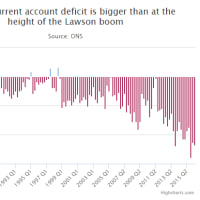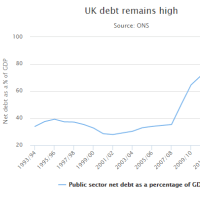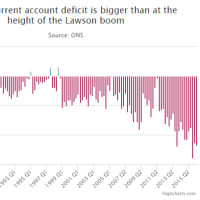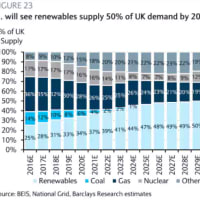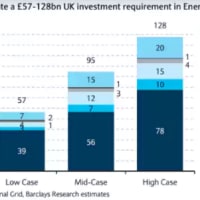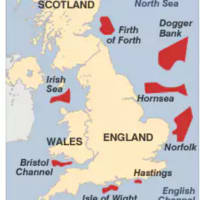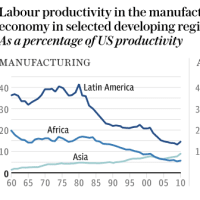BRICS risk 'sudden stop' as dollar rally builds
(BRICS:ドル高どんどんで「急停止」リスク)
By Ambrose Evans-Pritchard
Telegraph: 9:01PM BST 22 May 2013


(BRICS:ドル高どんどんで「急停止」リスク)
By Ambrose Evans-Pritchard
Telegraph: 9:01PM BST 22 May 2013
The stock of capital flowing into emerging markets has doubled from $4 trillion to $8 trillion since the Lehman Crisis, chasing a catch-up growth story that looks tired and has largely sputtered out in Brazil, Russia and South Africa.
新興市場に流入する資本は、リーマン危機以降、4兆ドルから8兆ドルへと2倍に増加し、ブラジル、ロシア、南アフリカでは息切れしているらしいキャッチアップ型成長ストーリーを追い求めています。
Much of the money has gone into debt, with falling economic returns. This is the next shoe to drop in the festering saga of global imbalances. All it will take is a gear-shift by the US Federal Reserve and the inevitable dollar surge that follows. It was the Volcker Fed that set off Latin America's defaults in the early 1980s. It was the mighty dollar that set off Mexico's Tequila crisis, and then the East Asian chain-reaction in the 1990s.
このお金の殆どは貸出に回っていますが、リターンは減少中です。
うんざりする世界的不均衡物語で、次にヤバくなるのはここでしょう。
FRBのギアチェンジとそれに否応なく続く米ドル急騰さえあればヨロシイのです。
1980年代初頭に南米諸国のデフォルトの引鉄を引いたのは、ボルカー連銀でした。
メキシコのテキーラ危機の引鉄を引いたのは、最強米ドルでした。
1990年代に東アジアで連鎖金融危機の引鉄を引いたのも、最強米ドルでした。
"Every emerging market blow-up that I have seen was preceded by a rise in the dollar," said Albert Edwards for Societe Generale.
ソシエテ・ジェネラルのアルバート・エドワーズ氏はこう語ります。
「僕が見てきた新興市場崩壊って、どれも米ドル高の後だよ」
"Investors overlook how vulnerable these countries are to a dollar shock. The whole process of excess liquidity and foreign reserve build-up goes into reverse. It acts like monetary tightening and turns into a vicious circle. Markets look for the weak link with the worst current account deficit, and then the dominoes start to fall," he said.
「投資家はこれらの国が米ドル・ショックにどんだけヤワイか、見て見ぬふりだよね。過剰流動性と外貨準備蓄積ってプロセスがまるごとひっくり返る。すると金融引き締めみたいなことになって、悪循環が始まるんだ。マーケットは経常収支が最悪の国を探す。そしてドミノが倒れ始めるってわけだ」
Fed chairman Ben Bernanke told Congress on Wednesday that "premature tightening" could abort the US recovery. There will be no "tapering" of quantitative easing until the fourth quarter. But passive tightening has begun. America's broad M3 money supply has been flat for months.
ベン・バーナンキFRB議長は水曜日に連邦議会で、「時期尚早な引き締め」は米国の景気回復を阻害するだろうと証言しました。
第4四半期まで量的緩和の「漸減」は行わない、と。
でも、受け身の引き締めは始まってますし。
米国のM3マネーサプライはもう何か月も横ばいです。
Former IMF official Stephen Jen, now at SLJ Macro Partners, foresees a "sudden stop", the moment when funding for emerging markets dries up abruptly and investors run for the exits.
元IMFで現在はSLJマクロ・パートナーズに務めるスティーヴン・ジェン氏は、「急停止」、つまり新興市場への資金が突然枯渇して、投資家が出口を求めて殺到した瞬間が訪れるだろうと予測しています。
Mr Jen said the flow of money before 2007 was "pulled in" by a genuine growth story, but what has happened since is different. Money has been "pushed out" of the West by QE in the US and Britain, or by the emergency stimulus in Europe, with liquidity washing through the global system.
ジェン氏曰く、2007年までの資金の流れは、本物の成長ストーリーに「引き寄せられた」ものだが、その後は違うとのこと。
資金は米英のQEによって、またはヨーロッパの緊急刺激策によって「押し出され」て、流動性は世界中のシステムに流れ込みました。
It is of "inferior quality", "fickle", and likely to be "fully reversed" as the Fed hoovers up excess money. The timing is in the hands of Bernanke, but the screws are already tightening for some in Asia, Latin America and the Mid-East as commodities deflate.
それは「低品質」で「気まぐれ」であり、FRBが過剰なマネーを改修すれば「180度逆転」する可能性が高いものです。
タイミングはバーナンキFRB議長次第ですが、商品価格が下落するにつれて、アジア、南米、中東の一部でネジは既に締められつつあります。
The cumulative inflow of capital has been 60pc of GDP in Lebanon, 58pc in Bulgaria, 56pc in Hungary, 50pc in Ukraine, 48pc in Poland, 42pc in Chile, 39pc in Romania, 32pc in Malaysia, 28pc in Thailand and 26pc in Turkey, to name a few. It can be good or bad. The devil is in the detail. But the overall level is what you see at cycle peaks. The IMF says the flows have been "ample but not alarming", yet also warned of a "sudden change in global market sentiment".
流入した資本の総額はGDP比にしてレバノンが60%、ブルガリアが58%、ハンガリーが56%、ウクライナが50%、ポーランドが48%、チリが42%、ルーマニアが39%、マレーシアが32%、タイが28%、トルコが26%ですが、これだけではありません。
良くもあり、悪くもあります。
悪魔は細部に潜んでいるんですね。
でも、全体的な水準は景気サイクルのピークで確認されるものです。
IMFに言わせれば、この流入は「豊かだが憂慮すべき」ものだそうで、更に「世界的なマーケット・センチメントの急変」を警告しました。
You can take a contrarian view, seeing the 12pc fall in the MSCI Index of emerging market stocks since early 2011 as a chance to pick up bargains. Bank of America says the sector "typically" beats the S&P 500 and Eurostoxx when the mood is this bearish. It depends whether you think the two-year drought is "typical", or the end of the road for a whole catch-up model.
逆張り的な考え方をして、MSCI新興市場指数が2011年初旬以来下落したのをバーゲン物を見つけるチャンス、と捉えることも可能です。
バンク・オブ・アメリカは、悲観的なムードの時、このセクターは「典型的に」S&P500やEUROSTOXXを上回るとしています。
2年間の日照りを「典型的」と考えるかどうか、それとも全てのキャッチアップ・モデルの終焉と考えるかどうか次第ですね。
South Africa has already become the first of the "BRICS" quintet to graduate from routine trouble to what looks like an old-fashioned Third World crisis. The current account deficit is 6pc of GDP. The rand plunged to a four-year low against the dollar this week, and 10-year bond yields have lost their footing.
南アフリカは既に「BRICS」で最初にいつものゴタゴタ卒業生となり、昔懐かしい第三世界危機みたいなものになりました。
経常赤字はGDPの6%に上っています。
南ア・ランドは今週、米ドルに対して4年ぶり最安に急落しましたし、10年債の金利はヤバいことになりました。
"Clearly a risk that all of us see is a sudden change in sentiment. Once there have been good inflows there might be unanticipated outflows,"said finance minister Pravin Gordhan.
「明らかに、僕らが目撃しているリスクは、センチメントの急変だよね。良い感じの流入があったら、想定外の流出だってあるかもしれないじゃん」とプラヴィン・ゴーダン財務相は言いました。
The fear is that South Africa is becoming ungovernable, with no end in sight to violent strikes by miners. Police opened fire on protesters at Lonmin's Marikana mine last year in a clash that killed 34 people.
心配なのは、南アフリカが統治不能になりつつあることで、鉱山労働者による暴力沙汰のストライキは終わりが見えません。
ロンミンのマリカナ鉱山で34人の死者を出した昨年の衝突では、警察がデモ隊に向かって発砲しました。
Brazil has not yet lost its halo but it has all the signs of stagflation, and remains stuck where it has been for half a century in the "middle income trap". Manufacturing output is lower today than in 2008, more like Italy than China. It is the result of an over-mighty real during the iron ore and agro-boom, and a bad case of the "resource curse".
ブラジルは未だそこそこですが、スタグフレーションの警報ランプは全て点灯していますし、半世紀に亘って「中所得国の罠」に囚われたままです。
製造業生産は2008年を下回り、中国よりもイタリアって感じです。
原因は、鉄鉱石・農作物ブームの間の酷いブラジル・レアル高でして、これは「資源の呪い」のあかんやつです。
Fiscal policy was too loose, countered by tight money, so the real soared. Dilma Rousseff's government tried to blame others with talk of "currency war". Now it is dabbling in protectionism. We have seen this story before in Latin America.
緩過ぎの財政政策に締め過ぎの金融というわけで、ブラジル・レアルは高騰したんですね。
ルセフ政権は「通貨戦争」を掲げて他国のせいにしようとしました。
今では保護主義だとかなんとか言い始めています。
昔も南米でこんなことあったなー、って感じですね。
Brazil's global ranking is 107 for infrastructure, 123 for roads, and 135 for ports, according to the World Economic Forum. The country never really overcame its bad habits. And much the same could be said of Russia, another resourse casualty that bet too heavily on oil and gas in the shale-shaken energy universe.
ブラジルのグローバル格付けは、インフラが107位、道路が123位、港湾が135位だそうですよ(WEF調べ)。
この国は本当に悪癖を捨てられた試しがないんですな。
ほぼ同じことはロシアにも言えるわけで、こちらも、シェールに引っ掻き回されたエネルギー業界で石油ガスに突っ込み過ぎちゃった、資源の呪いの被害者です。
Russia is not in crisis. Growth is sputtering along at 1.6pc. Manufacturing is up 1.2pc over the past year. But the BRICS story is essentially dead, a "Bloody Ridiculous Investment Concept", says Mr Edwards.
ロシアは危機じゃありませんよ。
成長率は1.6%でダラダラと。
製造業は過去1年間で+1.2%。
でもBRICS物語は基本的に終了ってことで、エドワーズ氏に言わせれば「Bloody Ridiculous Investment Concept(めっちゃオバカな投資コンセプト)」だそうですよ。
It is true that India has embraced free markets - sort of - and ditched the suffocating Hindu Model. Yet the old India is still there, grappling with power blackouts, a current account deficit of 6.7pc of GDP and a central and local budget deficit near 10pc of GDP.
インドが自由市場を受け容れた、窒息するようなヒンズー・モデルを放り出したってのは(或る意味)本当ですよ。
でもね、古のインドは今もそこに在って、停電に悩み、6.7%の経常赤字に悩み、10%の財政赤字に悩んでいるのであります。
Stripped bare, the BRICS miracle is really about China, and even the Politburo has run into diminishing returns after ramping up credit from $9 trillion to $23 trillion in four years. At best China will have settle for more pedestrian growth, but it too is at the mercy of the Fed.
ぶっちゃけ、BRICSミラクルって、中国のことなんですね。
で、その中国共産党ですら、4年間で信用を9兆ドルから23兆ドルにばーんと増やした挙句、収穫逓減に見舞われてます。
中国は良くてノロノロ成長、悪けりゃFRBの御心次第なのです。
By pegging its currency to the dollar it risks an exchange rate surge against the rest of Asia, compounding the effects of a 30pc rise against Japan's yen since last summer.
通貨を米ドルにペッグすると、他のアジア諸国に対して為替レートが急上昇する危険性があるんですね。
それに、昨年の夏から30%の日本円に対する値上がりが追い打ちをかけると…。
This looks all too like the mid-1990s, when the yen crashed against the dollar and gave China a brutal deflationary shock. China's $3.4 trillion foreign reserves will prove no defence. To deploy reserves the would entail conversion back into yuan, causing the currency to rise. It would exacerbate the shock.
なんかまるで1990年代中盤みたいですね。
あの時は日本円は米ドルに対して急激に値下がりして、中国に酷いデフレ・ショックを与えましたっけ。
中国の3.4兆ドルの外貨準備なんて、何の役にも立たないでしょうよ。
準備を使えば人民元高になりますし。
ショックに燃料投下ですよ。
To cap it all, this is happening just as China's trade surplus vanishes and American firms switch plant back to US soil for cheaper power and better labour productivity. The wheel is turning full circle.
しかも…中国の貿易黒字が吹っ飛んで、米企業が安い電力と労働生産性の改善を求めて米国回帰する中で、これは起こっているわけです。
歴史がくるっと回って元に戻りましたね。
Local stock markets have already priced in the new reality. Shanghai is off 70p from its 2008 peak in real terms. But foreigners who shovelled $8 trillion into their love affair with BRICS and bricklets have yet to adjust. European banks have lent $4.4 trillion to the bloc. Something to ponder.
中国の株式市場はこの新しいリアリティを織り込み済みです。
上海総合指数は2008年のピークを(実質で)70%下回っています。
が、BRICSその他のために8兆ドルを貢いだ外国勢の調整は今からであります。
欧州の銀行は4.4兆ドルも貸し込んでますから。
うーん…なんだかなー…。
These cycles of emerging market exuberance are as old as capitalism. They happened episodically all through the 20th Century, and all through 19th Century before that, usually ending with a cold douche. It should be no great shock if it happens yet again.
以上の新興市場空騒ぎサイクルは、資本主義と同じくらい古いものです。
20世紀を通じて時々起ってましたし、その前の19世紀だって同じです。
でもって、いつも冷水をぶっかけられて終わるんですね。
またそうなったって、驚くようなこっちゃないでしょ。











